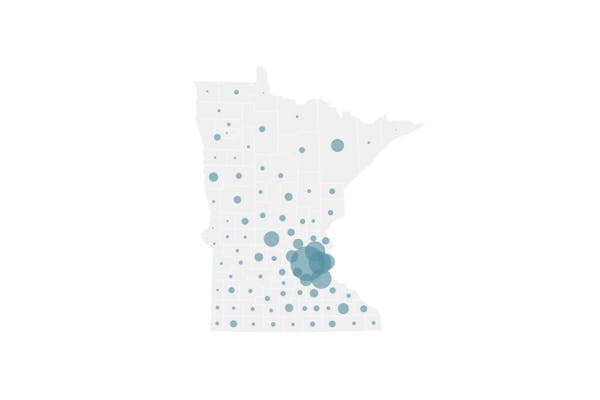The number of Minnesotans receiving intensive hospital care for COVID-19 infections has reached its highest point in the pandemic, new state health figures show.
The Minnesota Department of Health on Monday reported that 166 people with COVID-19 are in hospital ICU units, compared with 122 at this time last week. The state also reported another nine fatalities associated with the respiratory disease, which is caused by a novel coronavirus, increasing the death toll of the pandemic to 428.
The number of patients admitted to hospital ICUs has been closely watched by health officials, because such COVID-19 cases have always been tracked and are not subject to any variations in COVID-19 diagnostic testing. By comparison, the increase in total COVID-19 cases from 3,816 a week ago to 7,234 on Monday is largely influenced by increased testing statewide.
ICU-bed usage has been a key concern for state leaders due to projections that the peak of the pandemic could exhaust the state's hospital resources.
Gov. Tim Walz last week said the statewide stay-at-home order, which has been extended until May 18, bought hospitals time to prepare and add capacity. He added that he is now optimistic that all Minnesotans will have hospital beds and ventilators available to them if they suffer severe COVID-19 cases.
As of Monday, the state's COVID-19 preparedness website showed 986 of 1,244 hospital ICU beds in use — but another 1,344 such beds that could be readied within 72 hours.
Most people infected by the novel coronavirus suffer mild or no symptoms. So far, 4,212 confirmed COVID-19 cases have recovered and are no longer required to isolate themselves to avoid infecting others.
COVID-19 deaths remained most common among the elderly, long-term care residents and people with underlying health conditions — including asthma; diabetes; chronic kidney, liver or heart disease; or conditions that compromise the immune system. Smoking is also assessed by state health officials as a complicating factor. The median age of all COVID-19 cases is 47 but the median age of death is 83.
The number of patients in intensive care had remained steady for the last two weeks, before increasing over the weekend. State figures also showed another 230 people hospitalized for COVID-19, but not in intensive care.
The increase in hospital care of COVID-19 patients comes as Walz is expected to address the conditions under which hospitals and surgery centers could resume noncritical and elective surgeries and procedures.
Walz issued an emergency order suspending these procedures in order to preserve supplies of masks and gowns for caregivers at risk of infection from treating COVID-19 patients. The state's reserve supplies of such equipment have increased over the past month, though, and the governor has grown concerned about other medical conditions that are exacerbated due to surgical delays.
The Minnesota Medical Association, which represents the state's doctors, and other physician groups on Monday called for an easing of restrictions on medical procedures before the easing of broader public restrictions on bars, restaurants, malls, schools and other destinations.
"There are harms associated with COVID-19 morbidity and mortality as well as morbidity and mortality from delayed care and deferred access to needed services in non-COVID-19 patients," the medical groups said in a joint statement.
The Minnesota Nurses Association countered in a letter to the state health commissioner that guarantees on adequate PPE supplies are needed first to protect caregivers treating COVID-19 and to keep them on the job ahead of any surge of cases.
"The risks to resuming elective procedures before healthcare systems can prove that workers and patients in all settings can be protected from infection, are deadly," wrote Mary Turner, a nurse who treats COVID-19 patients at North Memorial Medical Center and president of the MNA union. "We stress that healthcare systems must meet these minimum criteria before resuming elective surgery."
Jeremy Olson • 612-673-7744
Twitter: @stribjo

Want to share info with the Star Tribune? How to do it securely

'Safe recovery sites' would offer syringes, naloxone and more to people using drugs. The plan could be in peril.
New Minnesota GOP leaders seek peace with party's anti-establishment wing

Who is Republican Lisa Demuth, Minnesota's first House speaker of color?

